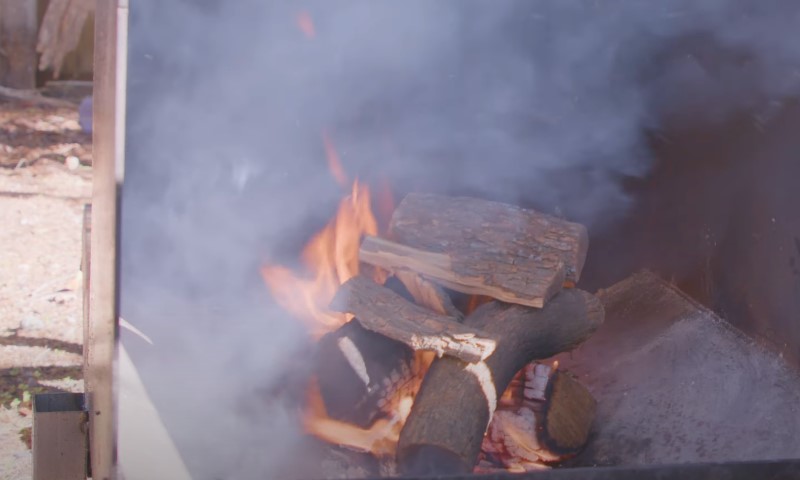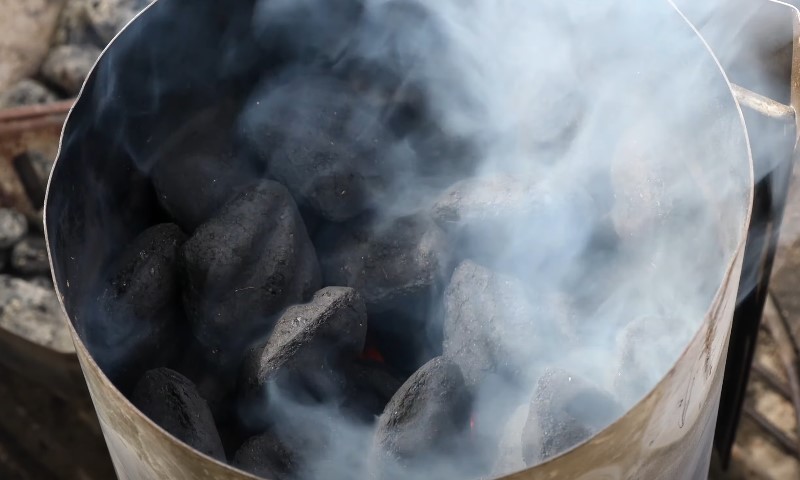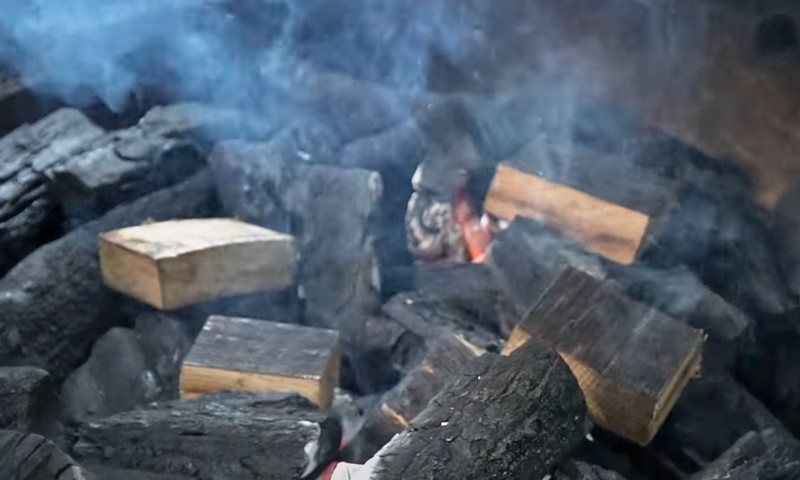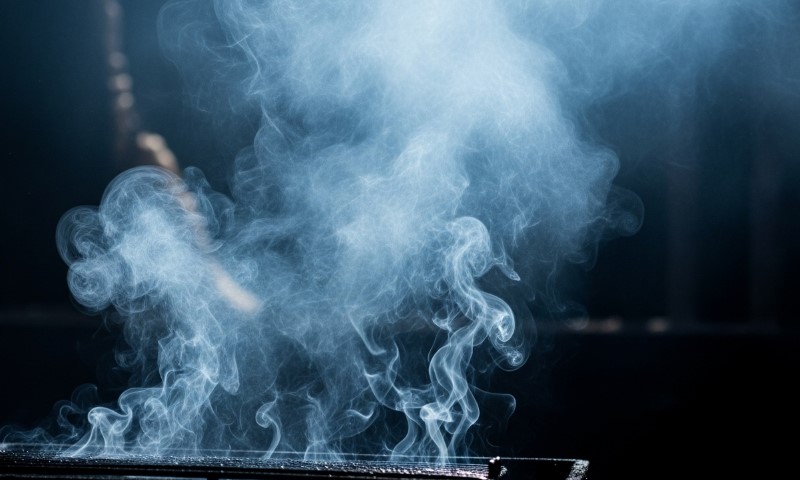Barbecue has its legends, its myths, and its secret codes. But ask any serious pitmaster what separates an average rack of ribs from the kind that makes people stop talking mid-bite, and you’ll hear about one thing over and over: blue smoke.
Not thick, ghostly puffs that look like the neighbor’s burning leaves, but a thin, nearly invisible haze that only shows itself when sunlight hits the stack just right. That faint tint of blue? It’s the holy grail of barbecue fire management.
Let’s break down what it is, why it matters, and how you can actually get it effortlessly.
Key Points
- Blue smoke signals a clean, efficient burn that flavors food without bitterness.
- It forms when wood gases burn clean in hot, oxygen-rich airflow.
- Pitmasters prize it for steady, balanced flavor and healthier combustion.
- Achieve it with dry wood, strong airflow, steady heat, and small fuel additions.
What Exactly Is Blue Smoke?
Blue smoke isn’t a special wood or a seasoning trick. It’s the sign of a clean, efficient burn. The particles are so tiny that they scatter light in a way your eyes read as faintly blue.
Think of it like a magic trick from physics: Rayleigh and Tyndall scattering, the same science that makes the sky blue and cigarette smoke look bluish in a sunbeam.
What it means for your meat is more important: clean combustion, free of heavy soot, creosote, and bitterness.
It’s why pitmasters prize it for long cooks like brisket, ribs, chicken, and fish. Instead of smothering the meat, it gently seasons over hours, laying down subtle layers of flavor.
Why Smoke Ever Looks Blue
When wood burns properly, it breaks down into gases and ultra-fine particles. Those particles, often sub-micron in size, scatter short wavelengths of light, blue ones, more strongly.
Under bright sunlight, that scattering creates the faint blue tint you see trailing out of a well-running pit.
Laboratory studies on combustion aerosols confirm it: the clean, flaming phases of wood combustion skew toward very small particles, while smoldering, oxygen-starved fires kick out bigger, dirtier ones.
What’s Actually in Wood Smoke?

A well-burning fire doesn’t just release one thing. It’s a cocktail of gases and particles:
- Water vapor from moisture in the wood
- Carbon dioxide and a touch of carbon monoxide
- Phenols and carbonyls that carry the aromas and flavors we associate with BBQ
- Organic compounds in tiny amounts
Starve that fire of oxygen or let it smolder, and you get a dirtier mix: tar, polycyclic aromatic hydrocarbons (PAHs), soot.
Health agencies track those compounds closely because they’re tied to air quality and, in some cases, health risks. For your pit, though, the takeaway is simple: cleaner fire, better flavor.
How Wood Turns Into Blue Smoke
Wood doesn’t just light and burn in one neat stage. It moves through a predictable sequence:
- Drying: Below about 212 °F, free water in the wood evaporates.
- Pyrolysis: Cellulose, hemicellulose, and lignin break down into combustible gases.
- Flaming combustion: Those gases ignite in hot, oxygen-rich air and burn clean.
- Charcoal combustion: What’s left, mainly carbon, burns slowly.
Blue smoke shows up in stages two and three, when those volatile gases are burned clean before they have a chance to condense into tar on your food.
Clean vs Dirty Combustion at a Glance
| Smoke Look | What It Signals | Flavor on Food | What to Adjust |
| Thick white billows | Wet wood, cold fire, or low oxygen | Acrid, sharp, sometimes tongue-tingling | Increase airflow, add heat, use drier wood |
| Gray with soot flecks | Smoldering fuel and tars | Bitter, ashy, dull bark color | Open vents, reduce fuel load, preheat splits |
| Thin blue or near invisible | Hot fire, good airflow, dry fuel | Sweet smoke aroma, clean finish | Maintain steadiness, small clean fuel additions |
Why Pitmasters Chase Blue Smoke
Pitmasters aren’t obsessed with blue smoke for looks, but about flavor and consistency. That faint haze is what gives meat its clean, balanced edge without the harsh, bitter notes of a dirty fire.
Flavor and Bark
Clean smoke lays down a delicate layer of flavorful phenols and carbonyls. Over hours, those compounds help build bark that tastes rich, not harsh.
Food scientists at Texas A&M point out that what you want to taste is the Maillard browning on the meat surface, not a layer of soot. Blue smoke keeps that balance.
Health and Safety
Nobody fires up a pit thinking about the National Cancer Institute, but it’s worth mentioning: incomplete combustion and flare-ups spike the formation of PAHs (as per the National Cancer Institute ).
Those compounds form when fat drips into a fire, ignites, and coats the food with smoke. You can minimize it by trimming excess fat, using drip pans, and keeping the fire steady.
The Environmental Protection Agency also notes that cleaner burns release fewer fine particles into the air, which is better for your food and your lungs.
The Smoke Ring Isn’t Blue Smoke
That pink halo in sliced brisket gets all the Instagram love, but it’s not a measure of smoke quality. The ring forms when nitric oxide from combustion binds to myoglobin in the meat, stabilizing the pigment.
How to Get Blue Smoke on Different Cookers
No matter what pit you’re working with, the goal stays the same: clean fire, steady airflow, and smoke that seasons without smothering. Different cookers just have their own quirks in getting there.
Offset Stick Burners
Offsets are made for it, but they demand attention:
- Start with a hot, clean base of coals.
- Open intake and stack vents wide to get a strong draft.
- Use small, seasoned hardwood splits (15–20% moisture).
- Preheat splits on the firebox so they ignite clean.
- Feed little and often, before the flame dies.
- Watch the stack: you want shimmer and a faint blue wisp, not billows.
Aaron Franklin popularized this approach for a reason: it works.
Charcoal Kettles
Different tool, same principle:
- Light coals in a chimney.
- Use the “minion” or “snake” method for gradual burn.
- Add wood chunks sparingly, let each ignite fully.
- Keep the top vent open, control temp with bottom vents.
Kamado and Ceramic Cookers
These run efficiently but can suffocate smoke if you choke them down too far:
- Light in one spot, let the dome preheat.
- Use fewer, larger chunks of wood.
- Wait for white smoke to fade before adding food.
- Keep the top vent slightly more open than you think.
Pellet Grills
Pellet cookers automate the process, but:
- Keep the burn pot clean.
- Use quality pellets to reduce ash and soot.
- Recognize that low temps may produce more visible smoke, while higher temps yield cleaner exhaust.
Fuel, Airflow, and Heat

Every clean fire depends on three levers you can actually control. Get the fuel right, move the air properly, and hold steady heat, and blue smoke shows up.
Fuel Quality
- Go with seasoned hardwood. If it hisses or smells sour, it’s not ready.
- Smaller splits light faster and burn cleaner.
- Preheat the next split before adding.
Airflow
- Exhaust wide open. Always.
- Use intake vents to fine-tune oxygen.
- Keep grates and fireboxes clear of ash.
Heat
- Aim for steady temps, usually 225–275 °F on offsets.
- Too cool = smoldering and bitter flavors.
- A bright flame is your best signal.
What Blue Smoke Tastes Like

It’s subtle, not overwhelming. Clean combustion produces phenols, carbonyls, and acids that build complex but balanced flavor. When creosote and soot dominate, the taste turns sharp, bitter, even tongue-numbing.
Most smoke flavor clings to the surface, so a thin stream of clean smoke over hours beats a heavy blast at the start.
Troubleshooting Common Problems
Even seasoned pitmasters run into hiccups. Fires misbehave, smoke turns ugly, and flavors go sideways. Here’s how to fix the usual suspects.
Problem: Thick white smoke, bitter bark
Cause: Wet wood or starved fire
Fix: Open vents, use small dry splits, preheat before adding
Problem: Acrid taste, sticky residue
Cause: Incomplete combustion, condensing tars
Fix: Run a little hotter, clean the pit, open exhaust fully
Problem: Flare-ups under fatty cuts
Cause: Dripping fat igniting on coals
Fix: Use drip pans, trim fat, reposition meat
FAQs
A Step-by-Step Checklist for Blue Smoke
- Use seasoned wood or quality charcoal.
- Light with a chimney or kindling bed, not smothered paper.
- Preheat the cooker and wait until white smoke fades.
- Keep exhaust fully open; regulate with intake.
- Add small, preheated splits (offsets) or modest chunks (ceramic/charcoal).
- Look for heat shimmer and a faint thread of smoke.
- Avoid flare-ups from fat drips.
- Clean ash and grease regularly.
Final Takeaway
Blue smoke is combustion science applied to BBQ. Tiny particles, clean fire, balanced airflow, and steady heat all come together to season meat in the gentlest, most flavorful way possible.
Pitmasters chase it not because it looks pretty (though it does), but because it delivers food that tastes clean, balanced, and deeply satisfying.
If you’re patient enough to tend a fire and smart enough to resist choking the vents shut, you can get there. And when you do, you’ll know it – not from the color of the smoke, but from the first bite of brisket that makes you close your eyes and grin.
